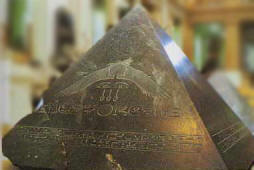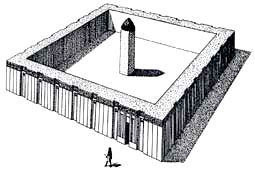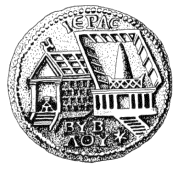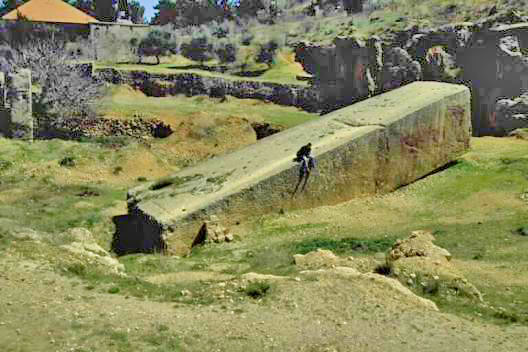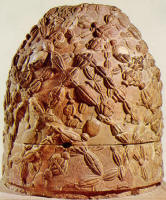FLYING SERPENTS AND DRAGONS
By R. A. Boulay 1990
Editorial Comments By Roberto Solàrion 1997
This fabled bird, which arose from its own ashes and thus became a symbol of regeneration, first became known to Western culture through the travels of Herodotus, when that famous Greek historian visited Egypt about 455 BC. At the ancient religious center of Annu, known to the Greeks as Heliopolis, Herodotus was told of a sacred bird which came from the East bearing its father embalmed in a ball of myrrh, and buried him in the Temple of the Sun at the city of Annu. The Egyptians called it the "Benu" bird, but it is better known by its Greek name of Phoenix. Additional details of the Phoenix were supplied by the Roman writers Tacitus, Pliny, and Ovid who also visited Egypt and reported further that the Phoenix built its nest on the Sun Stone at the Temple, where it perished in flames. It then rose out of the ashes to leave Egypt and not to return for 500 years. Herodotus was told that the bird resembled an eagle in size and shape, with golden and red plumage. Early Egyptian depictions, as far back as the 25th Century BC, show the "Benu" bird as a magpie. In later dynasties it appears as a heron with two long feathers growing from the back of its head. As we all know, legends are built around a kernel of truth that eventually becomes distorted with time. As each generation adds to the story, it becomes so encrusted that little is left of the former truth. In certain cases, however, like that of the Phoenix bird, sufficient ancient sources are available to enable us to trace its origin back to prehistoric times, and to discover the core of truth which precipitated the legend. The first available Egyptian reference to the "Benu" bird is from the times of the Old Kingdom when it is first noted inscribed on the walls of the burial chamber of the pyramid of Unas, the last king of the 5th Dynasty, circa 2400 BC. Called the Pyramid Texts, these carved inscriptions are a collection of spells and directions which gave the dead king all the information he needed for the trip to the afterlife and how to achieve it. Most authorities agree that the Pyramid Texts reflect the belief in a stellar cult that would require the deceased king to journey to the stars. Often he is pictured astride a serpent heading for a star constellation. His journey is an imitation of the Sun God himself, who was said to be able to traverse the sky in his "boat of heaven." An inscription found on the walls of the burial chamber of this king, describes the Sun God as rising from the Sun Stone or "Ben-Ben" Stone. It states,
At this time, the 25th Century BC, also known as Atum-Ra, Atum had become the dominant sun god and had supplemented Ra who had dominated the pantheon in the early days of Egypt. [Comment: This is a bit vague, as a result of the spelling of the word "Atum." In Egypt there were "Amon-Ra" and "Aten-Ra." One assumes that Aten-Ra is meant here, but the worship of Aten-Ra was connected with the much-later reign of Akhnaton in the New Kingdom. Zecharia Sitchin equates Amon-Ra with Marduk/Baal, and it is this editor's assertion that Duke Dumuzi equals Aten-Ra.] The so-called Pyramid Texts were later adopted by the commoners and painted on their wooden coffins. They thus came to be called the Coffin Texts, and eventually they were transcribed to papyrus becoming known as the Book of the Dead. Collectively, the three sets of texts are usually referred to as the Book of the Dead. You might say that it was their equivalent of a do-it-yourself manual on how to reach the gods in heaven and thereby achieve immortality.
THE SUN TEMPLE AND THE SACRED STONE The Phoenix bird has since its beginning been associated with the practice of sun worship in Egypt. This is noted in the coloring of the Phoenix, its miraculous birth, and its connection with fire, all symbolic of the Sun itself. These characteristics, however, lend themselves to a more interesting explanation, as we shall see. The inner sanctum of the Sun Temple at the City of Annu was the most sacred of all places. It was the home of the Sun Stone which the Egyptians called the "Ben-Ben." Mounted on a truncated pyramid, the "Ben-Ben" was a square stone platform upon which was set a pyramid-shaped stone or pyramidion, giving the appearance of stubby obelisk. It was on this stone that the Phoenix or Benu bird alighted. As far back as prehistoric times, the Sun Stone was revered as the dwelling of the Sun God. About 2000 BC, a new version of the Sun Stone appeared in Egypt - the pyramidion was placed on a tall square column and it became known as the obelisk. Obelisks were erected by all subsequent pharaohs. The capstone of the pyramids themselves were said to be pyramidions, and venerated as the physical dwelling of the Sun God. The dead king buried inside the pyramid was believed thus to be under the direct protection of the god himself. This pyramidion, which was used as the capstone on obelisks and pyramids, became the most sacred fetish of the Egyptians. The strange feature of the Phoenix legend is that it originated elsewhere and was assimilated into Egyptian sun worship by the priests of Annu at Heliopolis. The legends make it clear that the Phoenix bird came from the direction of the East, some say Arabia, others Assyria, and that it flies to the Sun Stone in Egypt to repeat its flaming performance. Since the Egyptians were very parochial in their view of the world, the land of Arabia could very well be any place east of the delta region.
THE MIDDLE EAST HOME OF THE PHOENIX In the lands of Palestine, Syria, and Lebanon, the Sun Stone was also revered as the dwelling of the Sun God. It was not only pictured as a stubby obelisk but quite often as an upright conical stone. At Byblos, the oldest of the Phoenician cities which dates to at least 3500 BC, the Egyptian gods were worshiped side by side with those of the Canaanite pantheon. Some of these sanctuaries contained a sacred chapel, an example of which is shown on a coin from Byblos of the Roman Emperor Macronus (AD 217) which evidently represents a shrine many centuries old. It shows a sacred enclosure containing a conical-shaped dwelling of the Sun God. The Sun Stone was called a "baetyl" or "betyl" by the Semitic peoples, and its functions are similar to the pyramid-shaped stone found in Egypt. "Betyl" is a Semitic version of the Hebrew term "Beth-el" meaning the dwelling or abode of God. In Palestine, the worship of the Sun Stone or Betyl goes as far back as the 8th Millennium BC. Digging in the ancient ruins of Jericho, archaeologists found at its lowest level, carbon dated to neolithic times of about 7000 BC, a temple where at its center an oval stone stood upright on a stone pedestal. These "betyl" stones were found all over the lands of Palestine and Syria. At Beth-Shean, an altar and betyl were found and dated to the mid-14th Century BC. Most of these "pagan" shrines were destroyed by the Hebrews after the division of the Kingdom of Solomon, but many still remain in the more isolated areas, such as in southeast Palestine near Arabia, in the land of the Nabateans. Found at high places, these altars appear as stone blocks or stubby obelisks and were believed by the natives to be inhabited by their chief deity Dushara. At Mada'im Salih, in northwest Arabia, the Nabateans left a necropolis of family tombs, many of whom have betyls or sacred stones. In fact, the Black Stone at Mecca called the "Kaaba," the most sacred of Islamic shrines, is believe to have fallen from the skies. It is also referred to as a betyl. [Comment: There are several peculiar legends circulating about the origin of the Kaaba stone.]
THE HELIOPOLIS IN LEBANON Besides the one in Egypt, there is another famous Heliopolis nearby, in Lebanon at a place now called Baalbek. Since antiquity, it has been a city sacred to the Sun God. The Old Testament calls it Beth-Shemesh or the "Abode of the Sun God," Shemesh or Shamash being the Semitic name for the Sumerian Sun God Utu. The land of Lebanon, known to the Sumerians as "the cedar land" was under the aegis of the Mesopotamian sun god. At Baalbek, the Greeks erected a splendid temple to their Sun God Apollo or Helios. It is also here that the Romans built a magnificent temple to their Sun God Jupiter. This temple was the largest they erected anywhere in the world, including Rome, indicating the importance they attached to this location. Even today, six of its mighty columns still stand, each 62 feet high and eight feet in diameter. But what is remarkable about this temple is that it is built on a massive three-tier stone base that must have been here long before the Greeks and Romans. It is raised 30 feet above the ground, and is paved with perfectly hewn and fitted stones ranging from 10 to 30 feet long and 6 to 9 feet wide. The base for this platform was constructed of cyclopean blocks of stone 32 feet long, 13 feet wide, and 12 feet thick. Each slab of stone is estimated to weigh 500 tons (for comparison, the largest stone in the Great Pyramid is 200 tons). A fourth stone lies in the quarry nearby (image below), readily shaped and cut except for a portion of its base. It is 72 feet long with a cross-section of 16 by 16 feet, estimated to weigh over 1200 tons. The stone was apparently intended to extend the size of the platform but operations seem to have suddenly ceased and the work was never completed.
Such a massive stone platform was obviously designed either to hold an immense weight, or for some operation that must have applied tremendous pressure on the ground, such as that exerted by a large rocket motor. The Lebanese Sun God Shamash who made him home base at Baalbek was in many ways similar to the Egyptian sun god. Like the Egyptian Ra who appears with the sun disc over his head, Shamash is always shown with a sun disc, containing a four-pointed star and four radiating spokes. And just like Ra, he is often depicted with the head of an eagle. Some scenes also show him holding the symbols of immortality. When Utu or Shamash left Baalbek, one of his destinations was ostensibly the City of Annu in Egypt where his bright arrival and departure in flames became the core of the legend of the golden and red Phoenix bird. For thousands of years throughout the whole Middle East, the betyl or Sun Stone became a sacred fetish revered as the physical dwelling of the sun god. Its conical or pyramidion shape was their attempt to represent the dwelling of the sun god, that is, the command or personal capsule of the first stage of a composite rocket. In Egypt, the origin of the Sun Stone is partially remembered in the ancient hieroglyphic sign used to represent the City of Annu or Heliopolis. It is shown as a bolt aimed at the sky.
THE GREEK OMPHALOS AS A BETYL AND GEODETIC MARKER Even the Greeks who came much later adopted the conical-shaped stone as a sacred dwelling of their Sun God Apollo. Called an "omphalos," it was the most sacred object at every oracular site. The Sun God Apollo, who later became one of the most important gods of the Greek Pantheon, originally came from Asia Minor, from Ionia. His cult first appeared on the Island of Delos from where it leap-frogged to Dodona on mainland Greece. In fact, the Island of Delos was considered so sacred that it was inviolate in all the Greek wars. Even the Persians respected its sanctity and bypassed it. In his Histories, Herodotus called Dodona the oldest of Greek oracles and archaeologists have traced it back to about 2000 BC. It was the first cult center to Apollo on the mainland. As Dodona declined in importance, Delphi replaced it as a cult center. Like Dodona, it also had a half-egg stone called an omphalos. Herodotus said that the omphalos here was wrapped with cord, one end of which was held by the Pythia or priestess as she queried the sun god in the stone. According to the Greek mythologist Robert Graves, the sacred stone at Delphi was also called "baetylos" by the Greeks. He refers to it as a cone-shaped pillar, periodically anointed with oil, and wrapped in raw wool on special occasions. It was the residence of a good, and was said to have fallen from heaven. (In Greek mythology, Baetylus was a son of the Sky God Uranus.) While the term "omphalos" means the human navel in Greek, its use here seems to be that of "the navel of the Earth." Besides being the residence of the Sun God, the omphalos was also a geodetic marker. It is interesting to note and pertinent to this subject, that if a line is drawn through the oracular sites of Dodona, Delphi, and Delos, and continued towards the mainland it runs right through Jerusalem. Like the Greek sites, Jerusalem has often been referred to in ancient documents as "the navel of the Earth," such as in Jubilees 8 as well as Ezekiel. It seems that there was some sort of geodetic grid connecting sacred places in ancient times. Shamash was also known as the god of justice and measurements. He is shown in one instance with two gods overhead holding cords connected to an altar which bears his sacred symbol. Therefore, it seems that the term "omphalos" was applied to the conical stone for its geodetic meaning, that is, as the geodetic point of a master grid. On the other hand, the term "baetylos" was used to mean the residence of a god and referred to in use as an oracular device. In summary, the Phoenix bird rising in flames became symbolic of the lift-off of the rocket craft of the ancient astronauts. Originally shown in conical configuration, an imitation of the command capsule, it later became angular-shaped under the Egyptians who used it as a capstone on pyramids and obelisks. Baalbek in Lebanon appears to be the original home of the Phoenix bird where a gigantic stone platform is all that remains of what was probably the main base for the chariots of the gods. |
